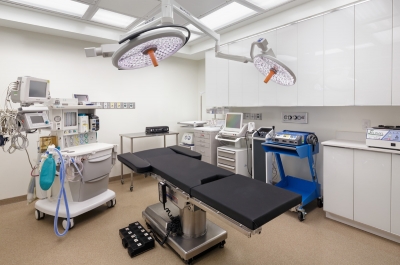There is appropriately significant focus and concern about the anesthesia required for aesthetic surgery. The following information is intended to give you some information on the topic if you are considering aesthetic surgery.

Anesthesia Consultation and Care:
The type and method of anesthesia used for your procedure is determined by Dr. Hirmand and our anesthesiologist, and is tailored to your particular case and medical history. Your particular preferences will also be taken into account and discussed in advance of your procedure.
Each patient is personally evaluated by our anesthesiologist, who performs a comprehensive review of the medical history, physical examination and laboratory results for safety. Patients have the option of speaking to the anesthesiologist directly and select patients will be personally contacted by the anesthesiologist prior to procedure.
Anesthesia Technology Highlights at our facility:
- GE anesthesia console
- Touch screen integrated Phillips monitors
- Bis Monitoring
- Fiberoptic Intubation Visualization Device
- Back up operating room monitor on site
General Anesthesia
General Anesthesia, or complete anesthesia with airway control and full monitoring, refers to the type of anesthesia that often utilizes a combination of medications to create a deep state of anesthesia.
Either an endotracheal tube (ET tube-breathing tube going through the vocal cords) or a laryngeal mask (LMA- tube attached to a mask that is placed behind the tongue so no tube goes through the throat). For aesthetic procedures, the individual is often breathing on his/her own regardless of the type of general anesthesia. It is important to realize that there is a spectrum of anesthesia and technology has enabled very close control and monitoring of the depth and type of anesthesia. Bis Monitoring, offered at our facility, for example, tracks the level of consciousness and brain waves, with strips placed on the forehead and gives the anesthesiologist constant data and feedback.
Sedation/ Monitored Anesthesia Care (MAC)
Sedation/ Monitored Anesthesia Care (MAC) also referred to as “twilight” anesthesia refers to situations where intravenous anesthetic agents administered by an anesthesiologist supplemented by local anesthesia in the area of surgery. The level of sedation can be adjusted from light to deep. In the light state, the person can interact verbally and open the eyes. However the general experience with this kind of anesthesia is a brief sleep with no memory of the procedure or of pain.
The evolution of anesthetic agent technology in the recent past has allowed for fast acting anesthetics that allow precise control of the depth of sedation at any point. It is also possible to give deep levels of intravenous sedation approaching essentially states achieved previously only with general anesthesia. This state of deep sedation may require additional monitoring by the anesthesiologist as compared to light sedation.
Local Anesthesia
Local Anesthesia refers to injection of anesthetic solution such as lidocaine directly in the tissues or around a nerve supplying the area in question (regional anesthesia). This type of anesthesia is used only in very limited types of procedures such as excisions, extremely limited liposuction or fat transfer procedures. There is minimal discomfort experienced at the time of injection. The individual is awake and aware and may feel some pulling or pressure but not pain. In some cases, it is recommended to take a valium or valium like medicine in conjunction, for more comfort.
Topical Anesthesia
Topical Anesthesia refers to creams with anesthetic agents the numb the skin. This type of anesthesia is reserved for light procedures that are performed on the skin such as microneedling and injectable treatments.
Pre and Peri-Operative Services
We have a comprehensive pre-operative medical clearance protocol as well as a pre-operative education protocol for your safety under anesthesia and during the recovery period. It is critical that you comply with these requirements as they are devised for your protection. It is also critical that we are aware of all your medical issues and all medications and supplements that you take in order to avoid any untoward reactions. Homeopathics and supplements as well as some complementary treatments such as lymphatic drainage and cleansing treatments are recommended as part of the pre-operative preparation. These are optional and are integrated into the pre-operative protocol to enhance recovery. Private duty nursing during the immediate post-operative period is recommended, and it is required for certain aesthetic procedures.